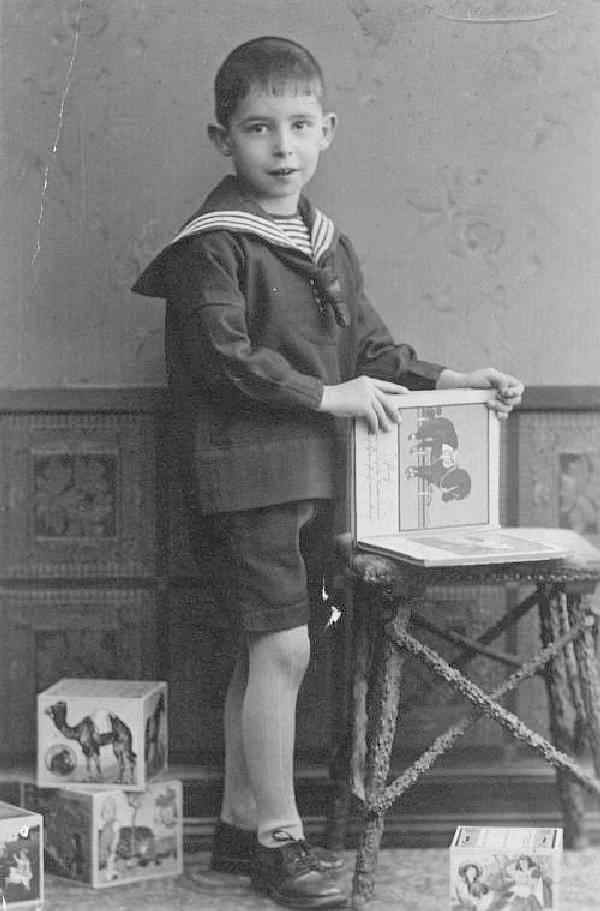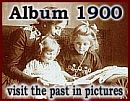
Unidentified German Boy (1920s)

Figure 1.--This German boy is seen with a picture book. He looks to about 5-6 years old and is just leaning to read. The portrait looks to have been taken about 1925. Click on the image to see the border of the postcard print. This mat help date the image. He wears very light-colored presumably tan stockings. It almost looks like he isn't wearing any hosiery at all. Image courtesy of Album1900.
|
There are many charming images on HBC. This is one of the images that we are most chatmed with and we arent sure why. He wears a classic sailor suit, but so do hundreds of boys archived on HBC. Perhaps it is his expression or the wonderful story book and large blocks. We are just not sure. Unfortunately we know nothing about this boy except that he is German. Even the date of the portrait is unknown. We would guess the portrait was taken about 1925, but that is only a rough estimate.
Chronology
The portrait here is unfortunately undated. This is unfortunate because it limits its usefullness in assessing clothing trends. Our guess is that the portrait was probably taken about 1925 or the late 1920s. The early 1930s is another possibility, but we tend to think that 1925-30 is the most likely period. We are almost sure that it was not taken in the 1910s. The reason for this is the shorts rather than kneepants with the three buttons, the tan stockings, and the low-cut shoes. These are all characteristics of boys clothibg in the 1920s rather than the 1910s.
Photographer
THe portrait here was printed as a postcard. Click on the image to see the border, which might help date the image. It was hard to read but the photographer was (I guess) F. Hartmann in Köln-Mülheim, Germany.
Location
Germany is a heavily industrialized country. It is thus generally safe to assume that the children shown in portraits lived in or near the city where the photographer is located. This would be especially true with boys in sailor suits. The sailor suit was especially popular with the German urban middle class. Rural children woukd have tended to have been dressed less fashionably. Thus we can assume this boy is from Köln or in English Cologne. This is an industrial city located alonged tghe Rhine in western Germany. I'm not sure about Mülheim.
Identity
Unfortunately we know nothing about this boy other than what can be observed looking at the portrait. We would guess that he is about 5 or 6 years old. He is either about to begin schoo; or has just entered school and has started to learn to read. Note that his book has some writing at the bottom of the pages. The sailor suit suggests to us that he comes from a properous middle class family. Sailor suits were very common in the 1910s. They were still very popular in the early 1920s, but we see fewer boys wearing them by the end of the decade.
Clothing
A reader writes, "I also think it is interesting that the boy is wearing light tan stockings (beige?) and almost modern looking shoes. His dickie or shield is striped to match the sailor collar. The almost knee length short trousers appear with very large hems (maybe to be let down) and there appears but I cannot be certain that he is not wearing ornamental buttons on the trousers. The middy sailor top may also have a large hem (the image is too hard to tell). The boy wears a knot tied but does not have a whistle. It also appears that he may have recently had a hair cut."
Sailor suit
The boy heres wears a fairly standard sailor suit. Notice the stripped dickey. I'm guessing it was actully a kind of early "T"-shirt. American boys tended to wear duckies with embriodered emblems. We have nited these stripped dickeies in continental countries, especially Russia and France. We see them less frequently in Germany. I was at first confused about the hosiery. I thought at first that he was wearing ankle sicks, but he must be wearing long stockings that are a light tan color and so well fitting that they could almost be mistaken for bare legs. We notice these tan stockings becoming popular in the 1920s after World War I. Also notice the modern-looking low cut oxford shoes.
A basic change in the color of long stockings occurred during the 1920s. Increasingly boys began wearing brown, beige and grey stockings, epecially by the mid-1920s. In most cases boys' long stockings were brown like the earth or as many remember, as chocolade. Also light brown stockings appeared, and to a more limited extent more brightly colored ones. Gradually lighter shades became the most common. Dark long stockings did not entirely disappear and might be worn for formal occassions. It was the lighter colors, however that contiued to be worn in West Germany until the late 1950s and into the 1960s in East Germany. When tights appeared in the late 1950s and early 60s, a much greater variety of colors appeared. A HBC reader writes, "As a general statement about long stockings, I think it is certainly true to say that brown shades was the usual color in Germany. But here I think we must distinguish between the brown plain stockings (this is almost certainly the color worn by the oldest boy in the suspender shorts image we got from the Hosiery Musuem) and the patterned stockings which tended to come in a variety of colors."
Shoes
Notice the low-cut oxford shoes. Many Grman boys in the early 20th century wore high-cut boot-like shoes. We see more boys wearing low-cut shoes in the 1920s. Often these were older boys, especially teen agers. The low-cut shoes are one reason that we do not believe that the boy here had his
Props
This photographic studio has some nice props for the children. The boy holds an interesting book. There are also great
large-size picture blocks in the background.
Reader Comments
A reader writes, "Just to add an uncertain comment on the boy's clothing, which interests me. The sailor suit seems to be quite usual for the period, about 1920, but I'm not sure I've seen the striped middy blouse underneath matching the striping on the boy's collar. This detail seems worthy of note. Also, the tan long stockings that he wears are so light in color that they almost give the appearance of flesh color. It became popular in Europe (especially
Germany) to substitute tan cotton stockings for the old-fashioned black ones that had been the usual color in the preceding decade, but these stockings seem unusually light in shade. Darker tan and brown long stockings became very common later in the decade and also into the 1930s in Germany. I'd be interested in the comments of our German readers on the color of the boy's stockings in this image. I'm also wondering about the boy's haircut--short bangs. In many of the photographs from the period boys in sailor suits have closely cropped, almost shaved, heads. The low cut shoes seem also an innovation for such an early photograph. I was under the impression that most
boys, at least in the years just preceding 1920, wore shoes that covered the ankle."
HBC

|
Album1900

|
Navigate the Boys' Historical Clothing Web Site:
[Return to Main German stockings brown color page]
[Return to
Main German large blocks toy page]
[Return to
Main German individual boy page]
[Introduction]
[Activities]
[Biographies]
[Chronology]
[Cloth and textiles]
[Clothing styles]
[Countries]
[Topics]
[Bibliographies]
[Contributions]
[FAQs]
[Glossaries]
[Satellite sites]
[Tools]
[Boys' Clothing Home]
Created: 4:58 PM 10/22/2004
Last updated: 4:58 PM 10/22/2004




